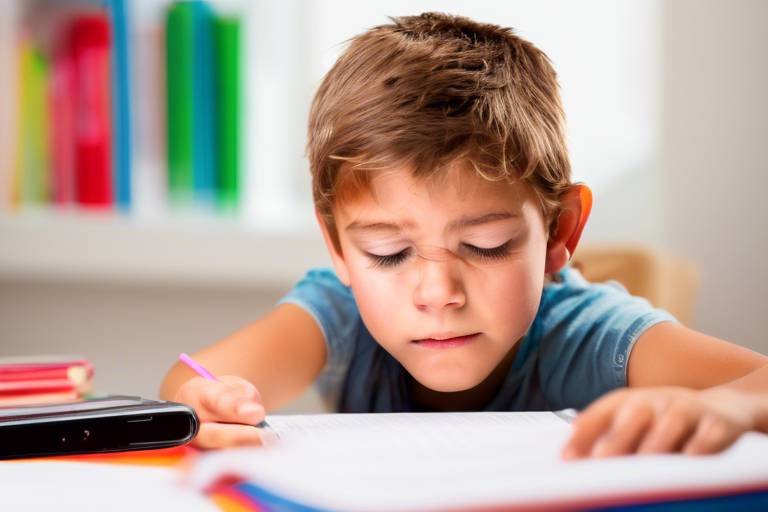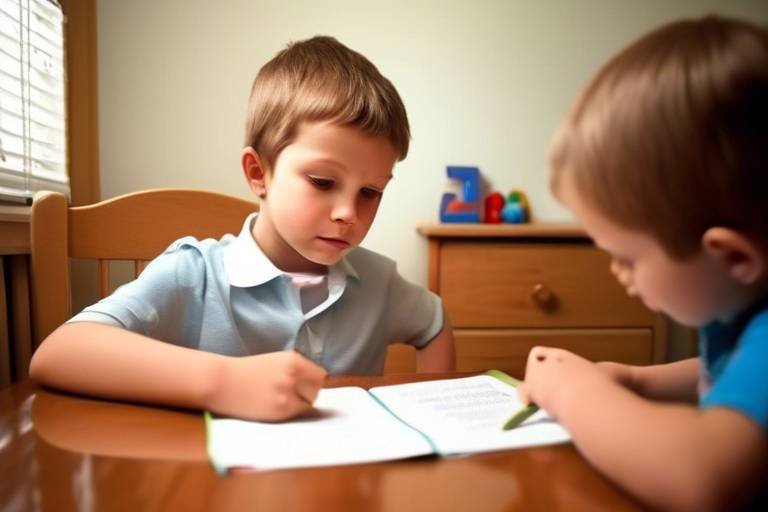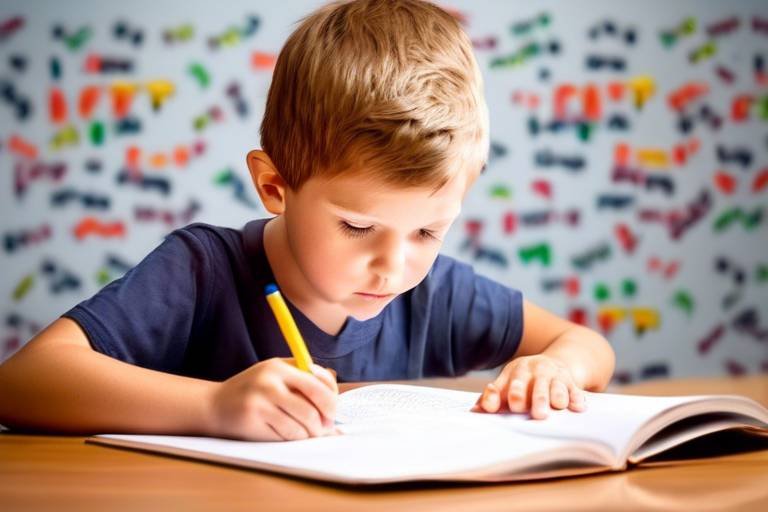Tips to Combat Procrastination in Kids
Procrastination can feel like a sneaky little monster lurking in the shadows of a child’s daily routine. It’s that nagging voice that whispers, “Why do it now when you can do it later?” As parents or educators, we often find ourselves scratching our heads, wondering how to help our kids overcome this habit. The good news is that there are effective strategies to combat procrastination and encourage a more proactive approach to tasks. In this article, we will explore practical tips and insights that not only tackle procrastination head-on but also nurture essential time management skills in children.
Before we can tackle procrastination, it’s crucial to understand why it happens in the first place. Kids are not just being lazy; there are often deeper psychological factors at play. For instance, they might feel overwhelmed by the task at hand, or perhaps they fear failure, leading them to avoid starting altogether. It’s like standing at the edge of a diving board, paralyzed by the thought of jumping into the unknown. Common triggers can include:
- Fear of Failure: The anxiety of not meeting expectations can be paralyzing.
- Lack of Interest: If a child finds a task boring, they are less likely to engage with it.
- Perfectionism: The desire to do things perfectly can lead to avoidance.
By recognizing these triggers, we can better support our kids in overcoming procrastination.
Spotting procrastination early is key to helping children get back on track. Some kids might not even realize they’re procrastinating until it’s too late. So, what should you look for? Here are some key behaviors that could indicate a child is struggling:
Watch for signs like:
- Avoidance: If your child consistently avoids certain tasks, it’s a red flag.
- Distraction: Frequent distractions, like scrolling through their phone instead of studying, can signal procrastination.
- Last-Minute Rush: If they always leave things to the last minute, it’s time to intervene.
By being vigilant about these behaviors, parents and educators can step in before procrastination becomes a habit.
It’s essential to understand the emotional landscape of a child’s mind when it comes to tasks. Many kids experience feelings of fear or anxiety that can hinder their ability to complete assignments. For example, a child might feel a surge of panic when faced with a big project, leading them to avoid it entirely. By addressing these emotional responses, we can help them build resilience and tackle tasks with confidence.
Don’t underestimate the power of peer influence! Friends can have a significant impact on a child’s motivation. If a child sees their friends prioritizing fun over responsibilities, they might follow suit. It’s like being part of a team where everyone is playing a different game. Encouraging positive peer interactions can help shift focus back to productivity.
Diving deeper into the reasons behind procrastination can lead to more effective solutions. Factors such as perfectionism or a lack of interest can be significant contributors. For instance, a perfectionist child might delay starting a project because they feel they can’t meet their own high standards. By addressing these root causes, parents can help their children develop healthier attitudes towards their tasks.
Now that we’ve identified the issues, let’s explore some practical strategies to encourage action and combat procrastination in kids. These tips can empower children to take charge of their responsibilities:
Establishing specific, achievable goals is essential for helping children stay focused. Instead of saying, “Do your homework,” try breaking it down into smaller, manageable tasks like, “Let’s finish the math problems first.” This approach helps kids see progress and motivates them to keep going.
A well-organized environment can minimize distractions and promote productivity. Consider setting up a dedicated workspace for homework that is free from distractions like TV and video games. A clutter-free desk can work wonders for a child’s ability to concentrate.
Q: How can I motivate my child to start their homework?
A: Start by breaking the homework into smaller, manageable tasks and set a timer for focused work sessions. Celebrate small achievements to encourage them!
Q: What if my child is overwhelmed by their tasks?
A: Help them prioritize tasks and tackle them one at a time. Offer support and reassurance to ease their anxiety.
Q: Can peer pressure really affect my child's procrastination habits?
A: Absolutely! Friends can influence a child’s motivation. Encourage positive friendships that promote a strong work ethic.

Understanding Procrastination in Children
Gaining insight into why children procrastinate is crucial for parents and educators alike. Procrastination is not merely a bad habit; it often stems from a complex interplay of psychological factors and environmental triggers. Children may delay tasks for various reasons, ranging from a lack of motivation to deeper emotional issues. Understanding these underlying causes can help us address procrastination more effectively.
One of the most common triggers for procrastination in children is the overwhelming nature of tasks. When faced with a big project, kids might feel like they are staring at a mountain too steep to climb. This can lead to feelings of anxiety and fear of failure, which often result in avoidance. Imagine a child looking at their homework like it’s a dragon they have to slay; instead of taking action, they might choose to hide under the covers and play video games instead.
Another significant factor is the influence of peers. Children are highly susceptible to social dynamics, and the desire to fit in can sometimes overshadow their responsibilities. If friends are prioritizing play over homework, a child might feel compelled to follow suit, even if it means letting tasks slide. This peer influence can create a cycle of procrastination that is hard to break, as kids may prioritize social acceptance over personal achievement.
Additionally, emotional responses play a critical role in procrastination. Children often experience a whirlwind of feelings when faced with tasks, including:
- Fear of failure: The thought of not meeting expectations can be paralyzing.
- Perfectionism: Some kids hold themselves to impossibly high standards, leading to avoidance of tasks altogether.
- Overwhelm: A lack of understanding of how to start or complete a task can trigger feelings of helplessness.
Moreover, the digital age has introduced a myriad of distractions that can further exacerbate procrastination. With smartphones, tablets, and computers at their fingertips, children can easily lose track of time while engaging in non-productive activities. This constant barrage of stimuli can make it challenging for them to focus on the tasks at hand.
In summary, understanding procrastination in children requires a multifaceted approach. By recognizing the emotional, social, and environmental factors that contribute to this behavior, parents and educators can better support children in developing healthier habits and time management skills. The journey to overcoming procrastination is not just about getting things done; it’s about fostering resilience and a proactive mindset that will serve children throughout their lives.

Identifying Signs of Procrastination
Procrastination in children can often be a silent struggle, masquerading as a simple delay in completing tasks. However, beneath the surface, it can manifest in various ways that are crucial for parents and educators to recognize. By identifying these signs early on, we can intervene and guide our children towards better habits. So, what should you be on the lookout for? Here are some common indicators that your child might be grappling with procrastination:
- Avoidance Behavior: If your child consistently finds excuses to avoid tasks, such as claiming they are "too tired" or "not in the mood," this could be a clear sign of procrastination.
- Distraction: Notice if your child is easily distracted by their surroundings or electronic devices when they should be focusing on homework or chores. This behavior often indicates a lack of motivation or overwhelming feelings towards the task at hand.
- Last-Minute Rush: If your child frequently waits until the last minute to complete assignments or prepare for tests, this behavior can lead to unnecessary stress and poor performance.
These behaviors can sometimes be accompanied by emotional responses that further complicate the situation. For instance, when faced with a daunting task, a child may experience feelings of anxiety or fear of failure. This emotional turmoil can create a vicious cycle, where the fear of not performing well leads to avoidance, further exacerbating procrastination.
Moreover, peer influence plays a significant role in a child's motivation levels. If their friends prioritize play over responsibilities, your child may feel pressured to follow suit, leading to procrastination. It's essential to understand that these social dynamics can have a profound impact on a child's ability to manage their time effectively.
Recognizing these signs is just the first step. Understanding the root causes of procrastination, such as perfectionism or a lack of interest in tasks, can provide deeper insights into how to help your child. By fostering an environment that encourages open communication and emotional expression, you can help your child develop healthier habits and overcome procrastination.
Q: How can I tell if my child is procrastinating?
A: Look for signs like avoidance behavior, distraction, and a tendency to rush tasks at the last minute. Emotional responses such as anxiety about completing tasks can also be indicators.
Q: What should I do if I notice these signs?
A: Start a conversation with your child about their feelings towards tasks and responsibilities. Understanding their perspective can help you provide the necessary support and encouragement.
Q: Can peer pressure contribute to procrastination?
A: Yes, peer influence can significantly affect a child's motivation. If their friends prioritize play over responsibilities, your child may feel compelled to do the same.
Q: How can I help my child overcome procrastination?
A: Implementing structured routines, setting clear goals, and creating a supportive environment can help children develop better time management skills and reduce procrastination.

Common Behavioral Indicators
Procrastination in children can manifest in various ways, and recognizing these behavioral indicators is crucial for parents and educators. When a child is consistently putting off tasks, it often becomes evident through certain behaviors that can signal deeper issues. For instance, you might notice a child frequently avoiding homework or chores, opting instead to engage in less important activities such as playing video games or scrolling through social media. This avoidance isn't just a harmless distraction; it can lead to a cycle of stress and anxiety as deadlines loom closer.
Another common behavior is a tendency to displace responsibility. Children may blame external factors for their procrastination, such as claiming they "didn't understand the assignment" or that "the dog ate my homework." These excuses can be a way to deflect attention from their lack of action, and they often indicate a fear of failure or an overwhelming sense of pressure to perform perfectly. This behavior not only impacts their current tasks but can also set a precedent for future responsibilities, creating a habit of procrastination.
In addition to avoidance and displacement, look for signs of distraction. A child who is easily sidetracked by their environment—whether it's a buzzing phone, a loud television, or even the allure of a snack in the kitchen—might struggle with maintaining focus on their responsibilities. These distractions can lead to a lack of productivity and increased frustration as children find themselves racing against time to complete tasks at the last minute.
Moreover, emotional responses play a significant role in procrastination. Children may exhibit signs of anxiety or frustration when faced with tasks they perceive as challenging. If a child bursts into tears or becomes irritable over a simple assignment, it may be a clear indication that they are overwhelmed. This emotional turmoil can further perpetuate procrastination, as the child may choose to delay the task rather than confront their feelings of inadequacy.
Finally, it's essential to consider the impact of peer influence on procrastination behaviors. Children often look to their friends for cues on how to behave. If their peers are dismissive of homework or prioritize leisure over responsibilities, a child may adopt similar attitudes. This social dynamic can foster a culture of procrastination, where completing tasks takes a backseat to fitting in or having fun.
In summary, recognizing these of procrastination—avoidance, displacement, distraction, emotional responses, and peer influence—can help parents and educators intervene effectively. By understanding these signs, adults can provide the necessary support and strategies to help children develop better time management skills and a more proactive approach to their responsibilities.
- What are some effective ways to motivate my child to complete their tasks?
Establishing a reward system can be beneficial. Offering small incentives for completing tasks on time can encourage your child to stay focused. - How can I help my child manage their time better?
Teaching them to break tasks into smaller, manageable parts can make them feel less overwhelmed and more in control of their time. - What role does a structured environment play in reducing procrastination?
A well-organized and distraction-free workspace can significantly enhance a child's ability to concentrate and complete their work efficiently.

Emotional Responses to Tasks
Understanding the emotional responses that children have towards tasks is crucial in tackling procrastination. Children often experience a rollercoaster of feelings when faced with responsibilities, which can lead them to delay or avoid completing their work altogether. Imagine a child staring at a pile of homework, feeling a wave of anxiety wash over them like a sudden storm. This emotional turmoil can stem from various sources, including fear of failure, perfectionism, or even a lack of interest in the subject matter.
One significant emotional response is fear of failure. Many children associate tasks with potential mistakes or poor performance, which can feel overwhelming. This fear can be paralyzing, leading them to procrastinate as a way to avoid confronting their anxieties. For instance, a child who struggles with math might put off doing their homework because they dread the possibility of getting questions wrong. By postponing the task, they feel a temporary relief, but this only exacerbates the problem in the long run.
Moreover, perfectionism plays a pivotal role in procrastination. Kids who set impossibly high standards for themselves may feel that if they cannot achieve perfection, it’s better not to try at all. This mindset can create a vicious cycle where the child avoids starting the task altogether, fearing that the outcome won't meet their expectations. It's like trying to climb a mountain without the right gear; the fear of slipping can stop them from even taking the first step.
On the other hand, emotional responses can also include feelings of disinterest or lack of motivation. If a child finds a task boring or irrelevant, they may not feel compelled to engage with it. The emotional disconnect can lead to avoidance behaviors, where the child chooses to play video games or scroll through social media instead of tackling their responsibilities. It’s essential for parents and educators to recognize that these feelings are valid and can significantly impact a child’s ability to complete tasks.
To help children navigate these emotional hurdles, it’s vital to create a supportive environment where they feel safe to express their feelings. Open communication can encourage kids to share their fears and frustrations, allowing parents to offer guidance and reassurance. Additionally, teaching coping strategies, such as breaking tasks into smaller, manageable steps, can help reduce anxiety and make the process feel less daunting. By addressing these emotional responses head-on, we empower children to face their tasks with confidence and resilience.
In summary, emotional responses to tasks are a significant factor in procrastination among children. By understanding and addressing these feelings, we can better support them in developing healthier attitudes toward their responsibilities, ultimately fostering a more proactive approach to their tasks.
- What are the main emotional triggers for procrastination in children?
Common triggers include fear of failure, perfectionism, and lack of interest in tasks. Understanding these emotions can help parents and educators address the root causes of procrastination.
- How can I help my child overcome their fear of failure?
Encourage open discussions about their feelings, and remind them that making mistakes is a part of learning. Celebrate their efforts rather than just the outcomes.
- What role does a structured environment play in reducing procrastination?
A structured environment minimizes distractions and helps children focus on their tasks. Setting up a dedicated workspace can enhance productivity and motivation.

Impact of Peer Influence
Peer influence plays a significant role in shaping a child's behavior and can be a double-edged sword when it comes to procrastination. On one hand, positive peer pressure can motivate children to stay focused and complete their tasks. On the other hand, negative influences can lead to procrastination, as kids may feel the need to conform to their friends' behaviors rather than prioritize their own responsibilities. Imagine a scenario where a child is surrounded by friends who prioritize fun over homework; this environment can create a sense of urgency to fit in, often at the expense of productivity.
When children see their peers engaging in procrastination, it can normalize the behavior and make them feel that it's acceptable to delay tasks. This is particularly true during formative years when social acceptance is paramount. The desire to be liked or included can overshadow their intrinsic motivation to complete assignments. Therefore, it is crucial for parents and educators to recognize the social dynamics at play and encourage children to foster friendships that promote positive behaviors.
Moreover, the impact of peer influence isn't just limited to direct interactions. Social media and group chats can amplify procrastination tendencies as children may find themselves distracted by the latest trends or ongoing conversations, leading them to sideline their responsibilities. To combat this, it's essential to foster an environment where children are aware of their choices and the implications of their social circles. Here are some strategies to consider:
- Encourage Open Dialogue: Talk to your child about their friends and how those relationships affect their motivation. Understanding their perspective can help you guide them better.
- Promote Positive Peer Relationships: Encourage your child to spend time with peers who value education and responsibility. This can create a supportive network that fosters productivity.
- Limit Distractions: Help your child set boundaries for their time on social media and gaming, especially during homework hours.
In summary, the impact of peer influence on procrastination is profound and multifaceted. By promoting positive social interactions and maintaining an open line of communication, parents and educators can help children navigate these influences effectively. It’s all about creating a balance between social engagement and personal responsibility, ensuring that friendships enhance rather than hinder their ability to manage time and tasks.
Q: How can I tell if my child's procrastination is influenced by their friends?
A: Look for patterns in your child's behavior. If they consistently delay tasks after spending time with certain friends, it may indicate negative peer influence. Discuss their feelings about these friendships to gain insight.
Q: What should I do if my child is spending too much time with procrastinating peers?
A: Have a conversation about the importance of balancing social life with responsibilities. Encourage them to seek friendships with peers who have a positive impact on their motivation.
Q: How can I help my child resist negative peer pressure?
A: Empower your child with decision-making skills and confidence. Role-playing scenarios can help them practice how to say no to distractions and prioritize their tasks.

Assessing Root Causes
When it comes to tackling procrastination in children, it's essential to dig deep and assess the root causes behind their behavior. Understanding why a child is putting off tasks can be the key to unlocking their potential and helping them develop better habits. Often, procrastination isn't just a matter of laziness; it can stem from a variety of psychological and emotional factors. For instance, one common root cause is perfectionism. Children who set unrealistically high standards for themselves may avoid starting tasks for fear of not meeting those expectations. This fear can create a cycle of avoidance, leading to more anxiety and ultimately, more procrastination.
Another significant factor to consider is a child's interest level in the task at hand. If a child finds a subject boring or irrelevant, they are much more likely to delay engaging with it. This lack of interest can manifest in various ways, such as daydreaming, scrolling through their phone, or even getting distracted by household chores that they suddenly find more appealing than homework. It's crucial for parents and educators to identify these interests and try to incorporate them into learning activities, making tasks more engaging and enjoyable.
Furthermore, the social environment plays a vital role in a child's motivation. Peer influence can be a double-edged sword; while friends can encourage positive behaviors, they can also lead to procrastination if a child feels pressure to conform to a more relaxed attitude towards responsibilities. For example, if a child's friends prioritize playtime over homework, they may be more inclined to follow suit, leading to a pattern of procrastination. Recognizing the impact of peer dynamics is essential in understanding a child's procrastination habits.
To truly assess the root causes of procrastination, it can be helpful to engage in open conversations with the child. Ask them about their feelings towards specific tasks and what they think is holding them back. Sometimes, simply giving them a platform to express their thoughts can lead to profound insights. Additionally, keeping a journal or a log of their tasks and feelings can help identify patterns over time. This reflective practice not only aids in understanding but also empowers children to take ownership of their actions.
| Root Cause | Description | Potential Solutions |
|---|---|---|
| Perfectionism | Fear of not meeting high standards | Encourage a focus on progress over perfection |
| Lack of Interest | Disengagement from boring tasks | Incorporate child’s interests into tasks |
| Peer Influence | Pressure from friends to prioritize play | Discuss the importance of balance with friends |
In conclusion, assessing the root causes of procrastination in children involves a multi-faceted approach. By understanding the psychological, emotional, and social factors at play, parents and educators can create tailored strategies that address these underlying issues. The journey to overcoming procrastination is not just about getting tasks done; it's about fostering a child's ability to manage their time, emotions, and relationships effectively.
Q: How can I help my child who is a perfectionist?
A: Encourage them to focus on progress rather than perfection. Celebrate small achievements and remind them that mistakes are a part of learning.
Q: What if my child is uninterested in their schoolwork?
A: Try to connect their interests with their school subjects. For example, if they love animals, relate their biology lessons to wildlife.
Q: How do I address peer pressure that leads to procrastination?
A: Have open discussions about the importance of balancing fun and responsibilities. Encourage your child to choose friends who share similar values regarding work and play.

Strategies to Encourage Action
Procrastination can feel like a heavy fog that rolls in and obscures the path forward for kids. To help them break free from this haze, it’s essential to implement effective strategies that encourage action. One of the most powerful methods is to establish clear goals. When children know exactly what they need to accomplish, it’s like giving them a map to navigate through their tasks. These goals should be specific and achievable, allowing kids to experience small wins that build their confidence and motivation. For instance, instead of saying, “You need to study for your test,” you could say, “Let’s review chapter three together for 30 minutes.” This clarity not only helps them focus but also reduces the overwhelming feeling that often leads to procrastination.
Another vital strategy is creating a structured environment. Imagine trying to work in a cluttered room with distractions everywhere; it’s nearly impossible to concentrate! By setting up a dedicated workspace that is free from distractions, parents and educators can significantly enhance a child's ability to focus. This space should be organized and equipped with all the necessary materials, such as books, stationery, and a comfortable chair. Additionally, establishing a routine can help children understand when it's time to work and when it's time to play, creating a healthy balance that promotes productivity.
Incorporating regular breaks is also crucial. Just like a runner needs to pause and catch their breath, kids benefit from taking short breaks during study sessions. This not only refreshes their minds but also prevents burnout. A good rule of thumb is the Pomodoro Technique, where children work for 25 minutes and then take a 5-minute break. This method can make tasks feel less daunting and more manageable, allowing kids to tackle their responsibilities with renewed energy.
Furthermore, it’s essential to involve children in the planning process. When kids have a say in how they approach their tasks, they are more likely to feel invested in their work. Ask them questions like, “How do you want to tackle your homework this week?” or “What’s the best way to prepare for your upcoming project?” This not only empowers them but also encourages accountability. When they take ownership of their tasks, they are less likely to procrastinate.
Lastly, positive reinforcement can work wonders. Celebrate their achievements, no matter how small. A simple “I’m proud of you for finishing your homework on time!” can boost their self-esteem and motivate them to keep going. You might even consider implementing a reward system where children earn points for completing tasks, which can be exchanged for a fun activity or treat. This approach makes the process of completing tasks more enjoyable and less of a chore.
- What are some signs that my child is procrastinating? Look for behaviors like avoiding tasks, excessive distraction, or consistently missing deadlines.
- How can I help my child set realistic goals? Encourage them to break larger tasks into smaller, manageable steps, and guide them in prioritizing these tasks.
- What if my child is resistant to change? Patience is key. Start with small adjustments and gradually introduce new strategies, allowing them to adapt at their own pace.
- Are there tools or apps that can help? Yes! There are numerous apps designed for time management and task organization that can make the process more engaging for kids.

Setting Clear Goals
Setting clear goals is like giving your child a roadmap for success. Imagine embarking on a road trip without a map or GPS; you’d likely feel lost and uncertain about where to go. Similarly, children need well-defined goals to navigate their tasks effectively. When goals are unclear or vague, it can lead to confusion and, ultimately, procrastination. By helping children articulate their objectives, we empower them to take charge of their responsibilities.
To start, it’s essential to involve your child in the goal-setting process. Ask them what they want to achieve and encourage them to express their thoughts. This not only boosts their motivation but also instills a sense of ownership over their goals. For instance, if your child has a school project, instead of simply saying, “You need to finish your project,” you could guide them to set specific goals like:
- Research the topic by Friday.
- Create an outline by Saturday.
- Draft the project by Sunday.
- Practice the presentation on Monday.
These clear, actionable steps break down the project into manageable parts, making it less daunting. Moreover, children can celebrate small victories along the way, which reinforces positive behavior and keeps them motivated. It’s like climbing a mountain; each base camp you reach is a reason to celebrate, and it makes the final summit feel achievable.
Additionally, it’s crucial that these goals are SMART: Specific, Measurable, Achievable, Relevant, and Time-bound. For example, instead of a vague goal like “do better in math,” a SMART goal would be “complete five math exercises every day for two weeks.” This specificity provides clarity, allowing children to track their progress and adjust their strategies as needed.
Another effective technique is to create a visual representation of these goals. A simple chart or a colorful poster can serve as a constant reminder of what they’re working towards. Visuals can be incredibly motivating, especially for younger children, who often respond well to bright colors and engaging designs. You might even consider using stickers or stars to mark off completed tasks, turning goal achievement into a fun and rewarding experience.
In conclusion, setting clear goals is an essential step in combating procrastination in children. It gives them direction, enhances their focus, and builds their confidence as they accomplish tasks. By fostering an environment where goal-setting is encouraged, we equip our children with the skills they need to tackle challenges head-on, paving the way for a more proactive and responsible approach to their responsibilities.
- Why is goal-setting important for children? Goal-setting helps children focus, enhances their motivation, and provides a sense of direction, reducing the likelihood of procrastination.
- How can I help my child set achievable goals? Involve them in the process, ensure the goals are SMART, and break them down into smaller, manageable tasks.
- What if my child struggles to stick to their goals? Encourage them to track their progress, celebrate small achievements, and adjust goals as necessary to keep them realistic and attainable.

Creating a Structured Environment
This article explores effective strategies to help children overcome procrastination, fostering better time management skills and encouraging a proactive approach to tasks and responsibilities.
Gaining insight into why children procrastinate is crucial. This section discusses common triggers and psychological factors that contribute to procrastination behaviors in kids.
Recognizing the signs of procrastination early can lead to timely interventions. Here, we outline key behaviors that indicate a child may be struggling with procrastination.
This subsection highlights typical behaviors, such as avoidance and distraction, that signal procrastination in children, helping parents and educators identify issues promptly.
Understanding the emotional reactions children have towards tasks can provide insight into their procrastination. This section delves into fear, anxiety, and other feelings that may hinder task completion.
Peer pressure can significantly affect a child's motivation. This part examines how friends and social circles can contribute to procrastination tendencies.
Digging deeper into the underlying reasons for procrastination can lead to more effective solutions. This section discusses factors like perfectionism and lack of interest.
Implementing practical strategies can help children overcome procrastination. This section presents actionable tips for parents and educators to motivate kids to take initiative.
Creating a structured environment is like setting the stage for a play; it prepares children to perform their best. The physical space where children work can dramatically influence their ability to focus and be productive. A well-organized environment minimizes distractions and helps kids develop a sense of routine. Imagine a cluttered desk filled with toys, snacks, and random papers – it’s easy to see how that chaos could lead to procrastination. Instead, a clean and designated workspace can encourage children to dive into their tasks.
To create this structured environment, consider the following key elements:
- Designate a Specific Workspace: Choose a quiet area in your home where distractions are minimal. This should be a place solely for studying or completing homework.
- Organize Supplies: Keep all necessary materials within reach. This includes stationery, books, and any other resources they might need. An organized space fosters an organized mind.
- Establish a Routine: Help your child create a daily schedule that includes time for homework, breaks, and play. Consistency is key in building good habits.
Additionally, it's beneficial to involve your child in the process of setting up their workspace. Ask them what they think would help them focus better. This not only gives them ownership over their environment but also encourages them to take responsibility for their tasks.
Moreover, consider the impact of external factors like noise and lighting. A well-lit room with minimal noise can significantly enhance concentration levels. You might even want to play soft background music if your child finds it helpful. Think of it as creating a soundtrack for their productivity, one that keeps them engaged without being overwhelming.
In conclusion, by creating a structured environment tailored to your child’s needs, you’re setting them up for success. It’s about providing them with the right tools and atmosphere to tackle their responsibilities head-on, transforming procrastination into action.
Q1: How can I tell if my child is procrastinating?
A1: Look for signs such as frequent distractions, avoidance of tasks, and a lack of progress on assignments. If they often seem overwhelmed or anxious about starting tasks, these could be indicators of procrastination.
Q2: What are some quick tips to help my child stop procrastinating?
A2: Start by setting small, achievable goals and breaking tasks into manageable chunks. Encourage regular breaks and provide positive reinforcement when they complete tasks.
Q3: Can a structured environment really make a difference?
A3: Absolutely! A structured environment reduces distractions and helps children focus better. It creates a sense of routine and stability, which is essential for effective learning.
Frequently Asked Questions
- What are the main reasons children procrastinate?
Children procrastinate for a variety of reasons, including fear of failure, perfectionism, lack of interest in the task, or feeling overwhelmed. Understanding these triggers can help parents and educators address the root causes effectively.
- How can I identify if my child is procrastinating?
Look for signs such as avoidance of tasks, frequent distractions, or a sudden interest in unrelated activities when they have responsibilities. If they often express frustration or anxiety about completing tasks, it may be a sign of procrastination.
- Are there effective strategies to combat procrastination in kids?
Absolutely! Setting clear and achievable goals, creating a structured environment, and breaking tasks into smaller, manageable parts can significantly help. Encouraging regular breaks and positive reinforcement can also motivate children to stay on track.
- How does peer influence affect a child's motivation?
Peer influence can play a significant role in a child's motivation. If their friends prioritize fun over responsibilities, it can lead to a similar mindset in your child. Encouraging friendships with peers who value hard work can help shift this dynamic.
- What emotional responses should I be aware of?
Children may experience a range of emotions, including anxiety, fear, or frustration when faced with tasks. Recognizing these feelings can help you provide the right support and encourage them to tackle their responsibilities more confidently.
- How can I help my child set realistic goals?
Start by discussing their interests and breaking down larger tasks into smaller, achievable goals. Make sure these goals are specific and measurable, and celebrate their achievements to boost their confidence and motivation.
- What role does the environment play in reducing procrastination?
A well-organized and distraction-free workspace can greatly enhance a child's productivity. Ensure their study area is clutter-free, well-lit, and equipped with the necessary tools to help them focus on their tasks.



















